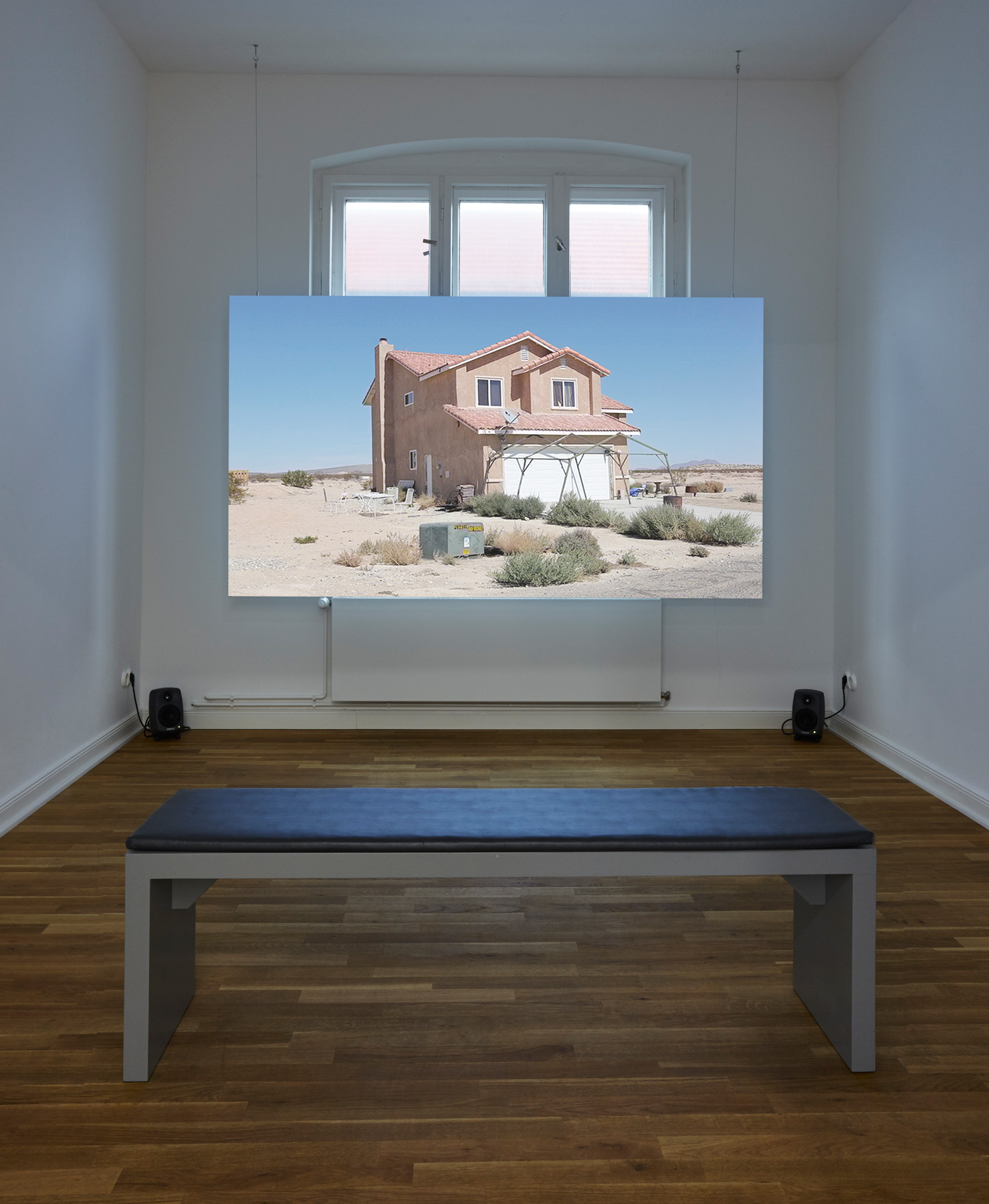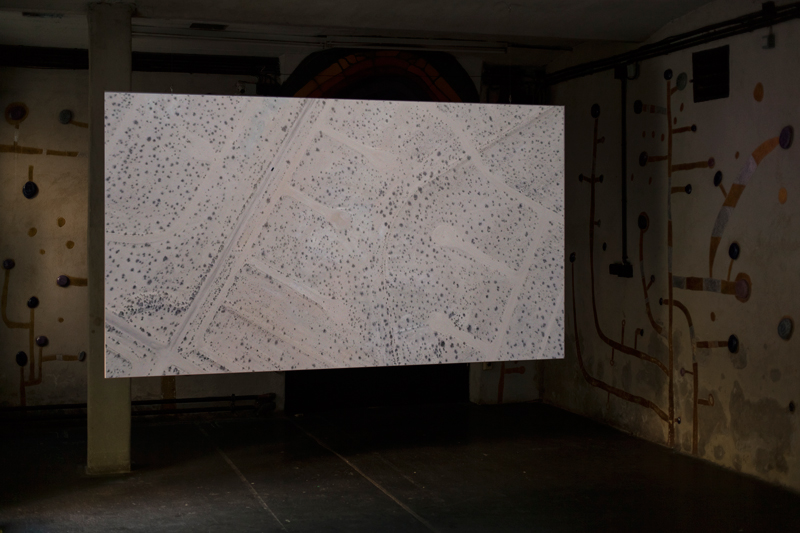


Video Installation, 12:30 min loop, Full HD, Stereo, 2015
Music by College
| – |
Land of the Sun was filmed in California City in November 2014. California City is the third-largest city in the state of California and is located in the Mojave Desert. The City had its origins in 1965 when real estate developer and sociology professor Nat Mendelsohn purchased 80,000 acres (320 km2) of Mojave Desert land with the aim of master-planning California's next great city. He designed his model city, which he hoped would one day rival Los Angeles in size, around a Central Park with an artificial lake and a golf course.
Growth did not happen anywhere close to what he expected. To this day a vast grid of crumbling paved roads, scarring vast stretches of the Mojave Desert, intended to lay out residential blocks, extends well beyond the developed area of the city. As of 2008, fifty years after Mendelsohn, California city had a total population of around 14000, living in a small town to the southwest of the vast empty grids.
Without showing any protagonists, the video is filmed with contemporary techniques (DSLR, POV ('dashcam') and aerial Drone photography) and focuses on the visible architectural leftovers of one of the world's biggest failed urban planning projects.
Text: Niklas Goldbach
| – |
[…] This ambivalent interrelation between utopia and dystopia underpins all of Niklas Goldbach’s works – sometimes more, sometimes less visibly. The towers of utopia always have a dark underside: paradise and ruin relate to each other like the tower and its negative counterpart, the foundation pit. But at the same time, the latter always precedes the former: in order to build something, one must first excavate. At times, however, the architectural paradise machines never get beyond the status of a ruined building – as in the case of the artificial island archipelago The World in Dubai or the street grid of California City, which is still visible in the Mojave Desert. Goldbach is interested in all these different stages of architectural (and social) utopia and shares his morbid fascination for post- and pre-apocalyptic landscapes through his artworks. And we as viewers begin to suspect that beneath the surface of every paradise machine lurks the abysmal void of the excavation pit […].
Inke Arns, excerpt from "The Paradise Machine - Of Towers and Foundation Pits in the Works of Niklas Goldbach"
Introductory text to the exhibition publication "The Paradise Machine", HMKV Dortmund, 16 March - 11 August 2024
Diese ambivalente Wechselbeziehung zwischen Utopie und Dystopie ist in Niklas Goldbachs Arbeiten stets präsent – manchmal stärker, manchmal etwas weniger stark sichtbar. Dabei wohnt den Türmen der Utopie gewissermaßen von jeher eine düstere Kehrseite inne: Paradies und Ruine verhalten sich zueinander wie der Turm und seine negative Entsprechung, die Baugrube. Diese geht jedoch gleichzeitig dem Turm immer voraus – um etwas zu bauen, muss zunächst eine Baugrube ausgeschachtet werden. Manchmal kommen die architektonischen Paradiesmaschinen jedoch über den Status einer Bauruine nicht hinaus – wie im Fall des künstlichen Inselarchipels The World in Dubai oder des in der Mojave-Wüste noch sichtbaren Straßennetzes von California City. Niklas Goldbach interessiert sich für all diese verschiedenen Stadien architektonischer (und gesellschaftlicher) Utopien und lässt uns in seinen künstlerischen Arbeiten teilhaben an seiner durchaus morbiden Faszination für post- und präapokalyptische Landschaften. Und wir als Zuschauer*innen beginnen zu ahnen: Unter der Oberfläche jeder Paradiesmaschine lauert die gähnende Leere der Baugrube.
Inke Arns, Auszug aus „Die Paradiesmaschine - Von Türmen und Baugruben in den Arbeiten von Niklas Goldbach",
Einleitungstext zur Ausstellungspublikation „The Paradise Machine", HMKV Dortmund, 16.3.- 11.8.2024
| – |
Land of the Sun was filmed in California City, California in November 2014. California City, which is the third largest city by area in the state of California, is located in the Mojave Desert. It was created in 1965 when real estate developer and sociology professor Nat Mendelsohn purchased 80,000 acres (320 km2) of Mojave Desert land with the aim of master-planning California’s next great city. He designed his model city, which he hoped would one day rival Los Angeles in size, around a central park with an artificial lake and a golf course.
Despite expectations, growth did not follow. Today a vast grid of crumbling paved roads covers huge stretches of the Mojave Desert. Intended to delineate residential blocks, the roads extend well beyond the developed area of the city. As of 2008, forty-three years after Mendelsohn bought the land, California City had a total population of around 14,000, clustered in a small town to the southwest of the empty grid. Free of human protagonists, the video focuses on the architectural leftovers of one of the world’s biggest failed urban planning projects.
The failure of the gigantic California City project reads like a prologue to the recent financial, real estate, and ecological crisis. Yet the city manager takes a positive view of future developments, pointing out that his city is located above a gigantic water reservoir. During the end of the video, we hear him say: “Now that California is in a drought, people will want to come where there’s a reliable water base — and California City has that to offer.
Houston FotoFest Biennial 2016, Catalogue Text
VIDEO EXCERPT
EXHIBITION VIEWS
Exhibition views:
Kunstpreis
der Stadt Nordhorn, Städtische Galerie Nordhorn, 2/2024
Curated by Thomas Niemeyer

Exhibition view:
The Mobile House Turns With The Sun
House of Egorn, Berlin, November 24th - December 22nd, 2018
Curated by Carola Uehlken
Exhibition view:
“Dongshisangyoung No.13”,
Euljiro, Seoul, South-Korea (Screening/Exhibition, September 2019)

Exhibition view:
FotoFest 2016 Biennial "Changing Circumstances"
Houston, Texas, USA, 2/2016
Curated by Steven Evans


Exhibition views:
"Enter the Void", Bülowstrasse 90 Berlin
13.11.- 22.11.2015
Curated by Stepahnie Kloss, Niklas Goldbach, Stefan Zeyen

 Installation views:
Installation views:
Exhibition views:
"Climate Changes Everything", Kunst Haus Wien _ Garage, 11.06- 27.08.2015
Curated by Raimar Stange
VIDEO STILLS





